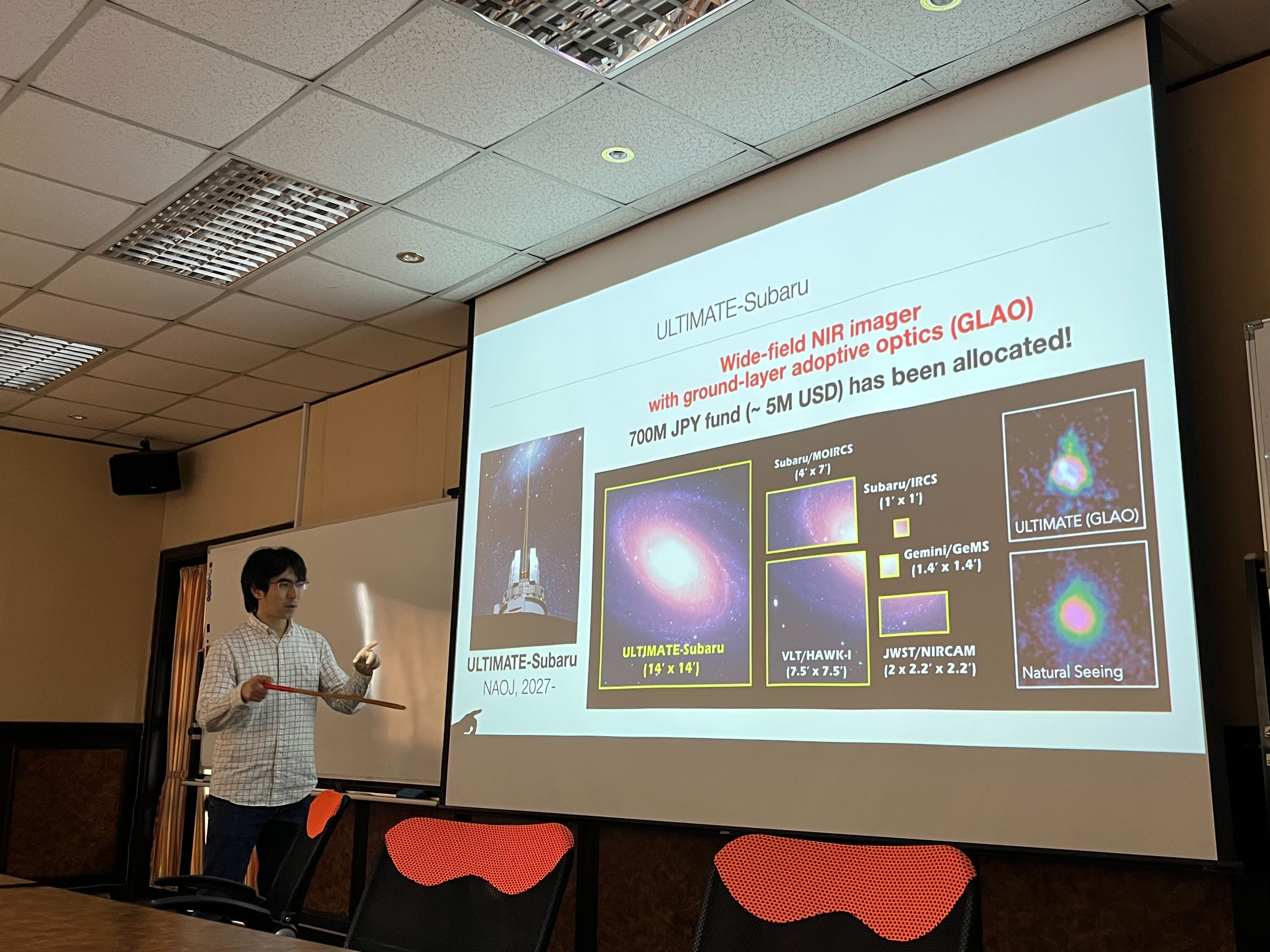Special Talk
Upcoming Special Talk
Special Talk List
| Date | Speaker | Title |
|---|---|---|
| 2025-09-17 | Dr. Edward Lin 林省文博士 (Department of Physics, University of Michigan) | Academic talk and career sharing |
| 2025-05-29 | Kuan-Ju Fu 傅冠儒 (Principal Engineer, Lithography Process Division, Process R&D Center, Taiwan Semiconductor Manufacturing Company, Ltd.) | Career sharing session (in Mandarin) |
| 2024-12-12 | Yi-Hsin Shih 施逸昕 (An owner of the Astronomy Bookstore 仰望書房) | Career sharing session (in Mandarin) |
| 2024-12-11 | Prof. Eric Hsiao (Florida State University) | Unraveling Supernova Secrets in the Infrared |
| 2024-10-24 | Lin Chien-Hsien 林建賢 (Systems Engineering Department of the Taiwan Space Agency (TASA))  | Career sharing session (in Mandarin) |
| 2024-03-26 | Prof. Takashi Moriya (NAOJ)  | High-redshift supernova surveys with the future near-infrared wide-field telescopes |
| 2024-03-07 | Dr. Michael H. Wong (UC Berkeley / SETI Institute / ASIAA Visitor) | Variable Atmospheric Composition Sampled by Planetary Probes |
| 2023-08-08 | Dr. Edward Lin 林省文博士 (Department of Physics, University of Michigan) | The Busted of Trojan Color Conundrum |
| 2023-08-07 | Dr. Edward Lin 林省文博士 (Department of Physics, University of Michigan) | A deep search across the primitive minor planets of the solar system |
| 2022-05-17 | Dr. Yue Shen (Univ. of Illinois at Urbana-Champaign) | Galactic-Scale Supermassive Black Hole Pairs at Cosmic Noon |
| 2022-04-12 | Dr. Matthew Holman (CFA) | The Continuing Search for Planet Nine 尋找第九行星 |
| 2022-03-19 | Prof. Stella S. R. Offner (Department of Astronomy, University of Texas at Austin) | Stellar Siblings: How Multiple Star Systems Form |
| 2022-03-18 | Prof. Stella S. R. Offner (Department of Astronomy, University of Texas at Austin) | Harnessing Machine Learning to Study Star Formation |
| 2022-03-15 | Dr. Chao-Lin Kuo (Stanford University) | Demystifying the Big Bang |
| 2019-08-23 | Dr. Gregory Herczeg (KIAA, Beijing) | The evolution of pre-main sequence stars and their protoplanetary disks |
| 2019-05-16 | 李傑信 博士 Dr. Mark Lee (美國NASA退休) | 宇宙的顫抖: 相對論與引力波 |
| 2019-01-04 | Dr. Cheng-Ling Kuo (Institute of Space Science, NCU) | Preliminary Results for Hyperspectrograph for Space Missions |
| 2018-12-28 | Dr. Loren C. Chang (Institute of Space Science, NCU) | Developing Spaceflight and Space Situational Awareness Capacity at NCU |
| 2018-12-21 | Professor Yue Shen (Department of Astronomy, University of Illinois at Urbana-Champaign) | The final parsec: time-domain exploration of the inner regions of quasars |
| 2018-12-14 | Dr. Yuki Inoue (Dept. of Physics, NCU) | Progress of KAGRA Gravitational wave interferometer and multi-messenger astronomy |
| 2018-12-07 | Dr. Yu-Jung Chen (Dept. of Physics, NCU) | The evolution of laboratory measurement of photodesorption of ices |
| 2018-11-30 | Dr. Shiang-Yu Wang and Dr. Youichi Ohyama (ASIAA) | SPICA-Taiwan: New Opportunities for MIR-FIR Science in 2030s |
| 2018-11-23 | Dr. Chow-Choong Ngeow (Institute of Astronomy, NCU) | Learning About RR Lyre in One-Hour |
| 2018-11-16 | Dr. Ekaterina Koptelova (Institute of Astronomy, NCU) | Molecular gas around supermassive black holes of quasars at redshift z>7 |
| 2018-11-13 | Dr. David Jewitt (Department of Astronomy, UCLA) | Two Freaks and a Conundrum |
| 2018-11-09 | Dr. Ying-Tung Chen (ASIAA) | Exploring Outer Solar System with Large Programs of CFHT and Subaru |
| 2018-11-02 | Dr. Yong Tian (Institute of Astronomy, NCU) | Is Dark Matter REAL? |
| 2018-10-26 | Prof. Wen-Ping Chen (Institute of Astronomy, NCU) | Journey to the West: My Sabbatical Adventures |
| 2018-10-19 | Prof. Yuan-Hann Chang (Dept. of Physics, NCU) | Study the cosmic rays with the AMS experiment on the International Space Station |
| 2018-10-12 | Dr. Chi-Ju Wu (Max Planck Institute for Solar System Research) | From the Sun to climate: solar activity over the last 9000 years |
| 2018-10-12 | Dr. Robin Thor (Max Planck Institute for Solar System Research) | Constraints on planetary interiors from laser altimetry |
| 2018-09-28 | Dr. Po-Chieh Yu (Institute of Astronomy, NCU) | ZTF Update |
